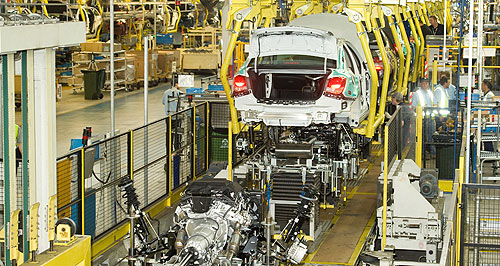Make / Model Search
News - HoldenHolden posts biggest-ever lossWrite-down: Holden made a $500 million one-off asset write-down on property plant and equipment last year after it announced that it would close its Adelaide car plant, Melbourne engine plant and related facilities in 2017. Record $553.8 million loss for Holden last year attributable to 2017 exit decision13 May 2014 By TERRY MARTIN UPDATED 10:30 AESTGM HOLDEN has recorded its biggest-ever annual loss of $553.8 million after its sales continued to fall last year and with the announcement in December that it was pulling out of manufacturing in Australia in 2017. Ford Australia has also this week posted a $267 million loss for 2013 as it, too, experienced a sales downturn in another record-breaking new-vehicle market and announced during the year that it would close down its production operations. In its financial results for 2013 released this week, Holden attributes the vast majority of the after-tax net loss to costs directly related to the decision to cease local vehicle and engine manufacturing, including a $500.4 million one-off asset write-down on property, plant and equipment. A $122.3 million charge for “employee separation costs” was also recorded. Consolidated revenue increased slightly from $4.02 billion in 2012 to $4.05 billion last year, which the company says was due to an increase in vehicle sales in the second half of 2013. However, sales for the full year fell 2.3 per cent to just over 112,000 units, the lowest point for Holden in around two decades as the Commodore dropped 9.1 per cent to a record-low 27,776 sales, while the Cruze small car – built alongside the Commodore in Adelaide – dropped 16.3 per cent to 24,421 units. Holden’s market share of 9.9 per cent was the first time in memory that the lion brand had fallen below 10 per cent. Sales and share have bounced back this year on the back of the doomed VF Commodore and derivatives and a single imported model, the Thai-built Colorado. Last year’s loss is considerably deeper than the $152.8 million loss Holden recorded for 2012, which marked a return to the red after a short run of positive results in 2010-11 broke a string of five successive losses from 2005 worth an accumulated $576 million that was capped by a record $210.6m loss in 2009. Holden says this latest record-low result is in line with expectations, having flagged at the exit announcement on December 11 that it expected to incur pre-tax charges of $400 million to $600 million in the fourth quarter of 2013 for the asset write-down and around $100 million for cash payment of exit-related expenses including certain employee severance costs. The loss comes despite receiving $86.2 million in taxpayer assistance last year. Ford, by comparison, received $72 million. “We are mindful of the impact on our employees and our financial results, but it was the right decision – manufacturing vehicles in Australia is, unfortunately, unsustainable,” said GM Holden’s chief financial officer Jeff Rolfs. “All three domestic OEMs have now announced they will cease domestic vehicle manufacturing as auto manufacturing in Australia faces a perfect storm of negative influences: a persistently high Australian dollar, one of the most fragmented and competitive markets in the world, and higher costs compared to other manufacturing source countries.” The company’s decision to close its manufacturing operations followed Ford’s announcement in May that it would exit in 2016 and contributed to Toyota’s decision in February this year to follow suit in 2017. Before the announcement, Holden had handed redundancy packages during the year to about 500 blue-collar workers at its Elizabeth assembly plant, Port Melbourne engine plant and Lang Lang proving ground, and had cut an undisclosed number of white-collar jobs, mostly from its head office and technical centre in Salmon Street, Port Melbourne. Its decision to close in 2017 will cut another 2900 jobs – 1600 from Elizabeth and 1300 from Holden’s Victorian workforce. Mr Rolfs said this week that Holden was “determined to support an orderly transition for employees”. “Last year, we recorded the initial allocations of our employee separation costs with further charges expected in this area,” Mr Rolfs said. “We are determined to work with all levels of government and the rest of the industry to deliver support, training and links to future opportunities for Holden employees impacted by our decision.” Mr Rolfs also said the key to returning Holden to “sustainable profitability” in future would be reducing its high fixed cost base. “We are profitable on our imported portfolio and Holden is focused on taking the right decisions to grow sales and revenue in the immediate term and manage our other costs very closely,” he said. “We will execute our business plan over the coming period to ensure Holden’s customers are at the centre of everything we do. “We will continue with the orderly delivery of key changes to our business to ensure that the Holden customer experience is second to none and that we build a successful future for Holden that honours our brand and our heritage.” Holden also said in its financial statement this week that it spent $145.2 million in 2013 on research and development, and paid $190.9 million “directly back into the economy” through combined taxes.  Read more6th of January 2014  VFACTS: Records smashed again as SUV, ute sales soarPassenger cars outnumbered as buyers opt for SUVs and utes in record numbers11th of December 2013  Breaking news: Holden calls it quits in AustraliaCar-making business to go as Holden moves to full importer by late 201712th of September 2013  Axe falls on Holden white-collar jobsEngineers among workers cut from Holden payroll as local car-maker slices costs8th of May 2013  Holden loses $152.8 million in 2012Unfavourable exchange rate, fewer sales cause Holden to lose $152.8 million in 2012 |
Click to shareHolden articlesResearch Holden Motor industry news |











Facebook Twitter Instagram